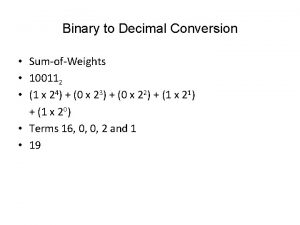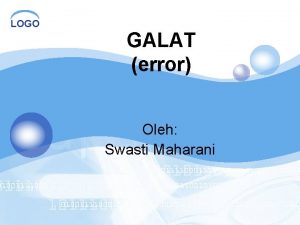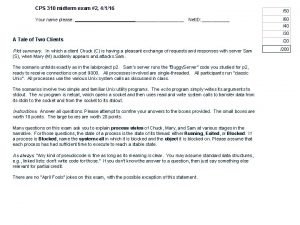CPS 196 2 Securities Expressive Securities Markets Vincent



























- Slides: 27

CPS 196. 2 Securities & Expressive Securities Markets Vincent Conitzer conitzer@cs. duke. edu

Call options • A (European) call option C(S, k, t) gives you the right to buy stock S at (strike) price k on (expiry) date t – American call option can be exercised early – European one easier to analyze • How much is a call option worth at time t (as a function of the price of the stock)? value pt(C) k pt(S)

Put options • A (European) put option P(S, k, t) gives you the right to sell stock S at (strike) price k on (expiry) date t • How much is a put option worth at time t (as a function of the price of the stock)? value pt(P) k pt(S)

Bonds • A bond B(k, t) pays off k at time t value pt(B) k pt(S)

Stocks value pt(S) k pt(S)

Selling a stock (short) value k pt(S) -pt(S)

A portfolio • One call option C(S, k, t) + one bond B(k, t) value k k pt(S)

Another portfolio • One put option P(S, k, t) + one stock S value same thing! k k pt(S)

Put-call parity • C(S, k, t) + B(k, t) will have the same value at time t as P(S, k, t) + S (regardless of the value of S) • Assume stocks pay no dividends • Then, portfolio should have the same value at any time before t as well • I. e. for any t’ < t, it should be that pt’(C(S, k, t)) + pt’(B(k, t)) = pt’(P(S, k, t)) + pt’(S) • Arbitrage argument: suppose (say) pt’(C(S, k, t)) + pt’(B(k, t)) < pt’(P(S, k, t)) + pt’(S) • Then: buy C(S, k, t) + B(k, t), sell (short) P(S, k, t) + S • Value of portfolio at time t is 0 • Guaranteed profit!

Another perspective: auctioneer • Auctioneer receives buy and sell offers, has to choose which to accept • E. g. : offers received: buy(S, $10); sell(S, $9) • Auctioneer can accept both offers, profit of $1 • E. g. (put-call parity): – – sell(C(S, k, t), $3) sell(B(k, t), $4) buy(P(S, k, t), $5) buy(S, $4) • Can accept all offers at no risk!

“Butterfly” portfolio • 1 call at strike price k-c • -2 calls at strike k • 1 call at strike k+c value c k-c k k+c pt(S)

Another portfolio • Can we create this portfolio? value pt(S)

Yet another portfolio • How about this one? value pt(S)

Two different stocks • A portfolio with C(S 1, k, t) and S 2 pt(S 2) b a isovalue curves k k+a k+b pt(S 1)

Another portfolio • Can we create this portfolio? (In effect, a call option on S 1+S 2) pt(S 2) k+b k+a b k a 0 k k+a k+b pt(S 1)

A useful property • Suppose your portfolio pays off f(pt(S 1), pt(S 2)) = f 1(pt(S 1)) + f 2(pt(S 2)) (additive decomposition over stocks) • This is all we know how to do • Then: f(x 1, x 2) - f(x 1, x 2’) = f(x 1) + f(x 2) - f(x 1) - f(x 2’) = f(x 2) - f(x 2’) = f(x 1’, x 2) - f(x 1’, x 2’)

Portfolio revisited • Can we create this portfolio? (In effect, a call option on S 1+S 2) pt(S 2) k+b k+a b k a x 2’ 0 x 1’ x 1 k f(x 1, x 2) - f(x 1, x 2’) ≠ f(x 1’, x 2) - f(x 1’, x 2’) Impossible to create this portfolio with securities that only refer to a single stock! k+a k+b pt(S 1)

Securities conditioned on finite set of outcomes • E. g. In. Trade: security that pays off 1 if Clinton wins Democratic nomination, 0 otherwise • Can we construct a portfolio that pays off 1 if Clinton wins Democratic nomination AND Giuliani wins Republican nomination? Giuliani loses Giuliani wins Clinton loses $0 $0 Clinton wins $0 $1

Arrow-Debreu securities • Suppose S is the set of all states that the world can be in tomorrow • For each s in S, there is a corresponding Arrow. Debreu security that pays off 1 if s happens, 0 otherwise • E. g. s could be: Clinton wins nomination and Giuliani loses nomination and S 1 is at $4 and S 2 at $5 and butterfly 432123 flaps its wings in Peru and… • Not practical, but conceptually useful • Can think about Arrow-Debreu securities within a domain (e. g. states only involve stock trading prices) • Practical for small number of states

With Arrow-Debreu securities you can do anything… • Suppose you want to receive $6 in state 1, $8 in state 2, $25 in state 3 • … simply buy 6 AD securities for state 1, 8 for state 2, 25 for state 3 • Linear algebra: Arrow-Debreu securities are a basis for the space of all possible securities

The auctioneer problem • Tomorrow there must be one of • Agent 1 offers $5 for a security that pays off $10 if or • Agent 2 offers $8 for a security that pays off $10 if or • Agent 3 offers $6 for a security that pays off $10 if • Can we accept some of these at offers at no risk?

Reducing auctioneer problem to ~combinatorial exchange winner determination problem • Let (x, y, z) denote payout under respectively • Previous problem’s bids: , , , – 5 for (0, 10) – 8 for (10, 0, 10) – 6 for (10, 0, 0) • Equivalently: – (-5, 5, 5) – (2, -8, 2) – (4, -6) • Sum of accepted bids should be (≤ 0, ≤ 0) to have no risk • Sometimes possible to partially accept bids

A bigger instance (4 states) • • • Objective: maximize our worst-case profit 3 for (0, 0, 11, 0) 4 for (0, 2, 0, 8) 5 for (9, 9, 0, 0) 3 for (6, 0, 0, 6) 1 for (0, 0, 0, 10) • What if they are partially acceptable?

Settings with large state spaces • Large = exponentially large – Too many to write down • Examples: • S = S 1 x S 2 x … Sn – E. g. S 1 = {Clinton loses, Clinton wins}, S 2 = {Giuliani loses, Giuliani wins}, S = {(Cl, Gl), (Cl, Gw), (Cw, Gl), (Cw, Gw)} – If all Si have the same size k, there are kn different states • S is the set of all rankings of n candidates – E. g. outcomes of a horse race – n! different states (assuming no ties)

Bidding languages • How should trader (bidder) express preferences? • Logical bidding languages [Fortnow et al. 2004]: – (1) “If Clinton wins OR (Giuliani wins AND Obama wins), I want to receive $10; I’m willing to pay $6 for this. ” • If the state is a ranking [Chen et al. 2007] : – (2 a) “If horse A ranks 2 nd, 3 rd, or 4 th I want to receive $10; I’m willing to pay $6 for this. ” – (2 b) “If one of horses A, C, D rank 2 nd, I want to receive $10; I’m willing to pay $6 for this. ” – (2 c) “If horse A ranks ahead of horse C, I want to receive $10; I’m willing to pay $6 for this. ” • Winner determination problem is NP-hard for all of these, except for (2 a) and (2 b) which are in P if bids can be partially accepted

A different computational problem closely related to (separation problem for) winner determination • Given that the auctioneer has accepted some bids, what is the worst-case outcome (state) for the auctioneer? • For example: • • • Must pay 2 to trader A if horse X or Z is first Must pay 3 to trader B if horse Y is first or second Must pay 6 to trader C if horse Z is second or third Must pay 5 to trader D if horse X or Y is third Must pay 1 to trader E if horse X or Z is second

Reduction to weighted bipartite matching • Must pay 2 to trader A if horse X or Z is first • Must pay 3 to trader B if horse Y is first or second • Must pay 6 to trader C if horse Z is second or third • Must pay 5 to trader D if horse X or Y is third • Must pay 1 to trader E if horse X or Z is second X 1 2 1 5 Y 2 3 3 5 2 Z 6 7 6 3
 How would you define efficient security markets
How would you define efficient security markets Sum of weights method decimal to binary
Sum of weights method decimal to binary Contoh soal galat
Contoh soal galat Homework 196
Homework 196 Sebuah kerangka kubus mempunyai volume 2
Sebuah kerangka kubus mempunyai volume 2 √54756
√54756 Odmocnina 196
Odmocnina 196 Cube root 11 to 20
Cube root 11 to 20 Saynn
Saynn Tipos de planejamento
Tipos de planejamento 196 883-dimensional monster
196 883-dimensional monster Bisp 196 ucsd
Bisp 196 ucsd Nilai binar dari nilai bilangan decimal 196 . ?
Nilai binar dari nilai bilangan decimal 196 . ? Cps boccaleone
Cps boccaleone Cps235
Cps235 Nielsen cps
Nielsen cps Cps 590
Cps 590 Cps template
Cps template E commerce bpcs
E commerce bpcs Cps506
Cps506 Ece252
Ece252 Cps 173
Cps 173 Cps 120
Cps 120 Go.cps.edu activate account
Go.cps.edu activate account Cps 510
Cps 510 Cps algebra exit exam
Cps algebra exit exam Cps north west
Cps north west Cps590
Cps590



















































